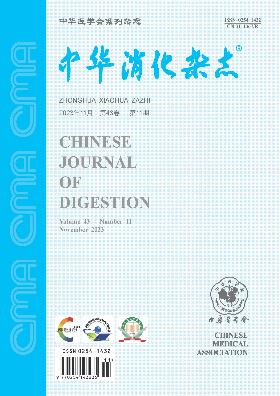Association of decoy receptors and osteoprotegerin gene polymorphisms with susceptibility and clinical phenotypes of Crohn′s disease
引用次数: 0
Abstract
Objective To investigate the correlation between decoy receptor (DcR)1, DcR2, osteoprotegerin (OPG) gene polymorphisms and susceptibility of Crohn′s disease (CD) in Han population in Zhejiang province. Methods From April 2008 to July 2017, at the Department of Gastroenterology of The Second Affiliated Hospital of Wenzhou Medical University, The First Affiliated Hospital of Wenzhou Medical University, Central Hospital of Wenzhou and Renmin Hospital of Wenzhou, 285 patients diagnosed as having CD were enrolled, and during the same period 572 healthy individuals who received health checkup at the Second Affiliated Hospital of Wenzhou Medical University were collected as healthy control. The single nucleotide polymorphism (SNP) of DcR1 (rs12549481), DcR2 (rs1133782) and OPG (rs3102735) were examined by SNaPshot technique. An unconditional logistic regression analysis was performed to analyze the differences in each SNP mutation alleles and genotype frequencies between CD group and control group. Furthermore, their correlation with clinicopathological features of CD and the efficacy of corticosteroid and infliximab was also evaluated. Results The frequencies of mutant allele A and genotype GA+ AA of DcR2 (rs1133782) of CD group were 11.93% (68/570) and 22.81% (65/285), respectively, which were higher than those of healthy control group (8.22%, 94/1 144; and 15.91%, 91/572; odds ratio (OR)=1.513, 95% confidence interval (CI) 1.088 to 2.104, P=0.013; OR=1.562, 95%CI 1.094 to 2.230, P=0.014). However there was no statistically significant difference in the mutant allele and genotype frequencies of DcR1 (rs12549481) and OPG (rs3102735) between two groups (all P>0.05). The frequencies of mutant allele C and genotype TC+ CC of DcR1 (rs12549481) in patients with stricturing CD were 13.89% (25/180) and 27.78% (25/90), respectively, which were lower than those of patients with non-stricturing, non-penetrating CD (27.68%, 62/224 and 48.21%, 54/112), and the differences were statistically significant (OR=0.421, 95%CI 0.252 to 0.705, P=0.001; OR=0.413, 95%CI 0.229 to 0.747, P=0.003). Besides, the frequencies of mutant allele A and genotypes GA+ AA of DcR2 in patients with penetrating CD were 7.23% (12/166) and 13.25% (11/83), which were lower than those of patients with non-stricturing, non-penetrating CD (15.62%, 35/224 and 30.36%, 34/112), and the differences were statistically significant (OR=0.407, 95%CI 0.205 to 0.809, P=0.009; OR=0.350, 95%CI 0.165 to 0.743, P=0.005). In addition, there was no statistically significant difference in the frequencies of mutant allele and genotypes of OPG (rs3102735) among subtypes of CD with different features (all P>0.012 5). Moreover, the DcR1 (rs12549481), DcR2 (rs1133782) and OPG (rs3102735) polymorphisms were not correlated with the efficacy of corticosteroid and infliximab (all P>0.05). Conclusions DcR1 (rs12549481) mutation may be correlated with stricturing CD. DcR2 (rs1133782) mutation may be correlated with CD, especially with penetrating CD. However, the gene polymorphism of OPG (rs3102735) is not correlated with the risk of CD susceptibility. And the above gene SNP may be independent of the efficacy of corticosteroid and infliximab. Key words: Crohn disease; Polymorphism, single nucleotide; Decoy receptor; Osteoprotegerin诱饵受体和骨保护素基因多态性与克罗恩病的易感性和临床表型的关联
目的探讨浙江省汉族人群诱饵受体(dcr1)、DcR2、骨保护素(OPG)基因多态性与克罗恩病(CD)易感性的相关性。方法2008年4月至2017年7月,在温州医科大学第二附属医院、温州医科大学第一附属医院、温州市中心医院和温州市人民医院消化内科共纳入确诊为乳糜泻的285例患者,并收集同期在温州医科大学第二附属医院进行健康体检的健康个体572例作为健康对照。采用SNaPshot技术检测DcR1 (rs12549481)、DcR2 (rs1133782)和OPG (rs3102735)的单核苷酸多态性(SNP)。采用无条件logistic回归分析CD组与对照组各SNP突变等位基因及基因型频率的差异。此外,还评估了它们与CD的临床病理特征以及皮质类固醇和英夫利昔单抗的疗效的相关性。结果CD组DcR2 (rs1133782)突变等位基因A和基因型GA+ AA的频率分别为11.93%(68/570)和22.81%(65/285),高于健康对照组(8.22%,94/1 144);15.91%, 91/572;优势比(OR)=1.513, 95%可信区间(CI) 1.088 ~ 2.104, P=0.013;OR=1.562, 95%CI 1.094 ~ 2.230, P=0.014)。两组间DcR1 (rs12549481)和OPG (rs3102735)突变等位基因及基因型频率比较,差异均无统计学意义(P>0.05)。狭窄性CD患者DcR1 (rs12549481)突变等位基因C和TC+ CC的频率分别为13.89%(25/180)和27.78%(25/90),低于非狭窄性、非穿透性CD患者(27.68%,62/224和48.21%,54/112),差异有统计学意义(OR=0.421, 95%CI 0.252 ~ 0.705, P=0.001;OR=0.413, 95%CI 0.229 ~ 0.747, P=0.003)。穿透性CD患者DcR2突变等位基因A和基因型GA+ AA的频率分别为7.23%(12/166)和13.25%(11/83),低于非狭窄性、非穿透性CD患者的频率(15.62%(35/224)和30.36%(34/112),差异有统计学意义(OR=0.407, 95%CI 0.205 ~ 0.809, P=0.009;OR=0.350, 95%CI 0.165 ~ 0.743, P=0.005)。不同特征CD亚型中OPG (rs3102735)突变等位基因频率和基因型差异无统计学意义(P>0.012 5), DcR1 (rs12549481)、DcR2 (rs1133782)和OPG (rs3102735)多态性与皮质类固醇和英夫利昔单抗的疗效无相关性(P>0.05)。结论DcR1 (rs12549481)突变可能与狭窄性CD相关,DcR2 (rs1133782)突变可能与CD相关,尤其是与穿透性CD相关,而OPG (rs3102735)基因多态性与CD易感性风险无关。上述基因SNP可能与皮质类固醇和英夫利昔单抗的疗效无关。关键词:克罗恩病;多态性,单核苷酸;诱饵受体;Osteoprotegerin
本文章由计算机程序翻译,如有差异,请以英文原文为准。
求助全文
约1分钟内获得全文
求助全文

 求助内容:
求助内容: 应助结果提醒方式:
应助结果提醒方式:


